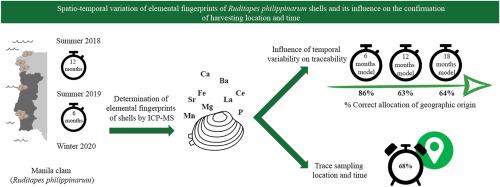Spatio-temporal variation of elemental fingerprints of Ruditapes philippinarum shells and its influence on the confirmation of harvesting location and time
IF 2.6
3区 地球科学
Q1 MARINE & FRESHWATER BIOLOGY
引用次数: 0
Abstract
Mislabeling and illegal, unreported, and unregulated (IUU) fishing of Ruditapes philippinarum has been previously revealed using the elemental fingerprints (EF) of shells to confirm their geographic origin. However, temporal variation in EF may compromise model accuracy, requiring frequent sampling and model updates. This study determined the EF of R. philippinarum shells sampled over three different times (summer of 2018, summer of 2019, and winter of 2020) from several locations along the Iberian Peninsula to: i) evaluate their suitability to confirm geographic origin and evaluate whether temporal variations in these EF influence the accuracy to confirm geographic origin by using samples collected at different times for model development and testing; and ii) determine if this EF based-tool can accurately confirm sampling time. Canonical analysis of principal coordinates (CAP) models accurately allocated samples of summer of 2018, summer of 2019, and winter of 2020 to their original locations (with 86.5 %, 92.2 %, and 97.7 % accuracy). Using the CAP developed with samples from the summer of 2018 and 2019 being used as reference models, samples collected 6, 12, and 18 months later were correctly allocated to their original location with 85.6 %, 63.3 %, and 64.4 % accuracy, respectively. Moreover, a different CAP model successfully allocated 68.3 % of samples to their correct sampling time. The results demonstrated the potential to confirm the sampling location of six-month-old samples, as well as to confirm sampling time. However, it is paramount to determine and continuously update, at least every six-months, a chemical reference library of EF to allow the reliable use of predictive models.

菲律宾蛤壳元素指纹图谱的时空变化及其对采收地点和采收时间确定的影响
以前,利用贝壳的元素指纹(EF)来确认其地理来源,发现了菲律宾Ruditapes philippine arum的错误标签和非法、不报告和不管制(IUU)捕捞。然而,EF的时间变化可能会损害模型的准确性,需要频繁的采样和模型更新。本研究确定了在三个不同时间(2018年夏季、2019年夏季和2020年冬季)从伊比利亚半岛的几个地点取样的菲律宾蛤壳的EF,以:i)评估其确认地理来源的适用性,并评估这些EF的时间变化是否会影响确认地理来源的准确性,使用不同时间收集的样本进行模型开发和测试;ii)判断该基于EF的工具能否准确确认采样时间。主坐标(CAP)模型的典型分析将2018年夏季、2019年夏季和2020年冬季的样本准确地分配到原始位置(准确率分别为86.5%、92.2%和97.7%)。使用以2018年和2019年夏季的样本为参考模型开发的CAP, 6个月、12个月和18个月后收集的样本被正确分配到原始位置,准确率分别为85.6%、63.3%和64.4%。此外,不同的CAP模型成功地将68.3%的样本分配到正确的采样时间。结果表明,有可能确定六个月大的样本的采样位置,以及确定采样时间。然而,最重要的是确定并持续更新,至少每六个月,一个EF的化学参考库,以允许可靠地使用预测模型。
本文章由计算机程序翻译,如有差异,请以英文原文为准。
求助全文
约1分钟内获得全文
求助全文
来源期刊
CiteScore
5.60
自引率
7.10%
发文量
374
审稿时长
9 months
期刊介绍:
Estuarine, Coastal and Shelf Science is an international multidisciplinary journal devoted to the analysis of saline water phenomena ranging from the outer edge of the continental shelf to the upper limits of the tidal zone. The journal provides a unique forum, unifying the multidisciplinary approaches to the study of the oceanography of estuaries, coastal zones, and continental shelf seas. It features original research papers, review papers and short communications treating such disciplines as zoology, botany, geology, sedimentology, physical oceanography.

 求助内容:
求助内容: 应助结果提醒方式:
应助结果提醒方式:


